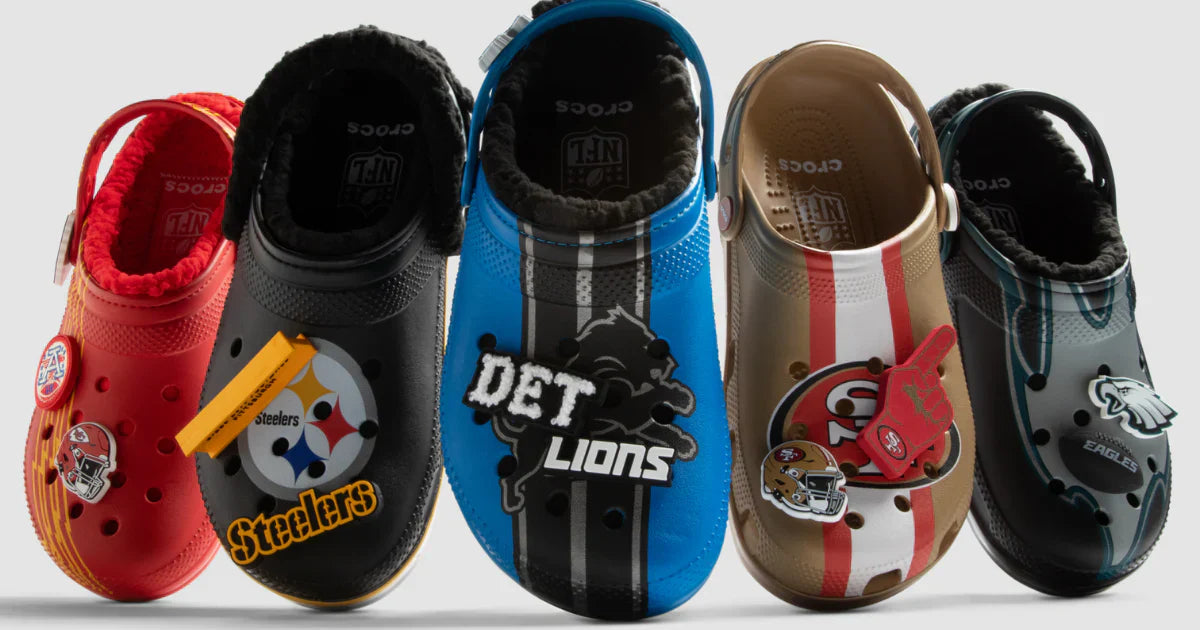In today’s sports marketing landscape, the lines between fandom and lifestyle are blurring. Gone are the days when supporting a team was confined to game days, jerseys, and stadium seats. Instead, fans are looking for ways to weave their passion into everyday life—and brands are responding with products and partnerships that extend well beyond the arena.
A perfect example? The NFL’s recent multi-year licensing deal with Crocs, which launched team-branded clogs and Jibbitz charms ahead of the 2025 season. Far from a gimmick, the partnership taps into a powerful trend: sports as a lifestyle identity.
Why Lifestyle Matters for Sports Brands
Sports have always been about belonging. Whether it’s painting faces on Sunday or sharing highlight reels on Monday, fans crave ways to showcase their loyalty. But modern fandom is no longer just about what happens during the game—it’s about continuous connection.
Lifestyle integrations give fans the chance to:
-
Express identity daily: Wearing team-inspired shoes, bags, or accessories keeps loyalty visible, even outside the stadium.
-
Blend fashion and fandom: Sports merchandise is no longer just about oversized hoodies; it’s about stylish, versatile items that fit into everyday wardrobes.
-
Connect socially: These products spark conversations—whether it’s a co-worker noticing your sneakers or a friend commenting on a team-themed accessory.
For brands, lifestyle integration transforms fans into walking billboards—authentic, self-driven ambassadors who market the brand every time they step out the door.
The Crocs x NFL Case Study
Crocs’ partnership with the NFL is strategic genius. Crocs already dominate casual footwear, particularly among younger consumers who prize comfort and playful customization. By introducing team-branded clogs and collectible Jibbitz, the NFL extends its reach into fans’ daily routines.
Why it works:
-
Accessibility: Not everyone can afford season tickets, but $60 team Crocs make fandom attainable.
-
Versatility: Fans can wear them to the gym, the grocery store, or the tailgate—bridging the gap between casual and fan-centric fashion.
-
Customization: With Jibbitz charms, fans can personalize their footwear, blending creativity with allegiance.
The result? A partnership that drives revenue, builds visibility, and creates cultural buzz.
Lessons for Sports Marketers
-
Go Beyond the Jersey
Fans want items that fit seamlessly into their lifestyle. Think sneakers, handbags, tech accessories, or even home goods—products that make fandom practical and stylish.
-
Prioritize Collaboration
Partnering with fashion-forward or culturally relevant brands (like Crocs) allows sports organizations to tap into new audiences who may not yet identify as die-hard fans.
-
Lean Into Customization
Today’s consumers value personalization. Adding customizable elements—whether digital or physical—makes the experience stickier and fosters emotional connection.
-
Think Everyday Touchpoints
From morning coffee mugs to commuter backpacks, the more touchpoints a brand creates, the more constant the fan connection becomes.
Looking Ahead: The Future of Lifestyle-Driven Fandom
As younger generations blur the boundaries between sports, fashion, and culture, lifestyle integrations will only grow more powerful. Expect to see:
-
Athlete-driven fashion lines that rival traditional designers.
-
Sports-infused tech wearables that double as fitness gear and fan merchandise.
-
Purpose-led collaborations (e.g., eco-friendly, women-owned, or culturally inclusive brands) that resonate with values as much as with style.





Sky Sports retains exclusive US Open golf rights until 2030
US sports rights spending hits US$30.5bn in 2025